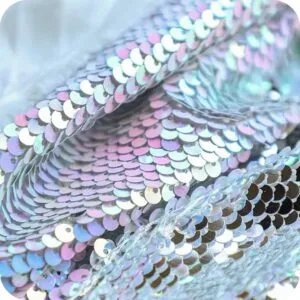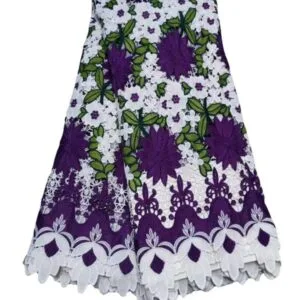
Embroidered fabric is a textile that has intricate designs or patterns sewn onto it using thread. This art form dates back thousands of years and has evolved with the advancement of technology and the introduction of various types of #embroidery techniques. From traditional hand-embroidery to modern machine #embroidery, these fabrics offer unique aesthetic appeal and functional benefits in fashion and interior design.
Embroidered fabric, also known as #embroidered textiles, is made by stitching thread or yarn onto a fabric base to create decorative patterns. The fabric used in embroidery can be anything from #cotton, #linen, or #silk to #polyester, depending on the desired effect and end use. #Embroidery can be done by hand or with a machine, and the type of stitches used can vary depending on the complexity of the design.
Embroidery Techniques
There are several different #embroidery techniques that can be applied to fabrics. Each technique creates a distinct texture and visual effect. Below are some of the most common embroidery methods:
1. Hand Embroidery
Hand embroidery is the most traditional form of embroidery. Skilled artisans use needles and threads to manually stitch designs onto fabrics. This technique is time-consuming but offers great versatility in terms of design. Some common stitches include #satinstitch, #chainstitch, #stemstitch, and #Frenchknots. Hand-embroidered fabrics are often used for high-end fashion, home décor, and custom designs.
2. Machine Embroidery
Machine #embroidery is a more modern technique that uses computerized machines to stitch patterns onto fabric. This method is faster and more precise than hand embroidery and allows for larger production runs. It is commonly used in commercial settings, such as for mass production of embroidered clothing, sports uniforms, and promotional products. Machine #embroidery offers the flexibility to replicate intricate patterns with high consistency.
3. 3D Embroidery
3D #embroidery adds a textured, raised effect to fabric by using foam or other materials beneath the stitches. This creates a bold, dimensional look, making it a popular choice for creating logos or brand symbols on clothing, caps, and other accessories.
4. Appliqué Embroidery
#Appliqué embroidery involves sewing a piece of fabric onto another fabric to form a design. The edges of the fabric are stitched down, often with a decorative stitch, and the fabric can be cut into various shapes to form patterns, such as flowers, animals, or abstract designs. This technique is commonly used in creating quilted items, table linens, and garments.
5. Cutwork Embroidery
Cutwork involves cutting out parts of the fabric to create a lace-like effect, often combined with embroidery to fill in the empty spaces. This technique is delicate and sophisticated, making it ideal for fine #linens and wedding garments. It adds an element of elegance to the fabric, creating a sheer, intricate design.
6. Bead Embroidery
In #beadembroidery , small beads are stitched onto fabric to create a design. This method adds sparkle and texture to the fabric and is often used in eveningwear, accessories, and couture fashion. Beads can be sewn in a variety of patterns, creating intricate and luxurious designs.
Benefits of Embroidered Fabric
The inclusion of embroidery in fabric not only enhances its aesthetic appeal but also provides several practical benefits. Some of the advantages of embroidered fabrics include:
1. Visual Appeal
One of the main reasons why #embroidered fabrics are so popular is their visual appeal. The intricate designs and fine details of #embroidery add texture, depth, and richness to the fabric. This makes it a preferred choice for high-end fashion, including dresses, blouses, and eveningwear. Embroidery can also transform plain fabrics into more sophisticated, luxurious materials.
2. Customization
Embroidery allows for high levels of customization. Whether it’s for a company logo, a unique design for a fashion collection, or personalized gifts, #embroidery offers the flexibility to add any text or graphic. For example, logos are often embroidered onto uniforms, promotional items, and corporate gifts. Customized embroidered fabrics can be ordered in bulk and serve as a promotional tool for businesses.
3. Durability
Unlike prints that may fade over time, embroidered designs are durable and resistant to wear and tear. The threads used in embroidery are sewn into the fabric, which makes the designs less likely to fade or peel. Embroidered fabrics maintain their quality over time, even with frequent washing, making them ideal for clothing, home textiles, and accessories.
4. Luxury and Elegance
Embroidery has long been associated with luxury and sophistication. Intricate designs, particularly those created using fine threads such as silk, can elevate the look of the fabric and make it appear more expensive. Embroidered fabrics are often used in bridal wear, couture fashion, and luxury home décor, such as embroidered curtains, bed linens, and tablecloths.
5. Versatility
Embroidered fabrics are versatile and can be used for a wide range of applications. Whether in the fashion industry or for home furnishings, embroidered fabrics can be customized for different uses. The type of fabric and stitch chosen will affect the overall outcome, allowing manufacturers and designers to create both subtle and bold effects.
Applications of Embroidered Fabric
Embroidered fabric is widely used in different sectors, from fashion to home décor, to create beautiful and functional products. Some of the most popular applications of embroidered fabrics include:
1. Fashion
Embroidered fabric is a staple in the fashion industry. Designers often use embroidery to create detailed and ornamental designs for garments. Whether it’s delicate floral patterns on a silk blouse, intricate geometric designs on a cotton dress, or bold logos on sportswear, embroidered fabrics add a level of sophistication to fashion pieces. Embroidery is also commonly used for accessories, such as handbags, scarves, and shoes.
2. Home Décor
In home décor, embroidered fabrics add elegance and charm to a variety of items. Embroidered curtains, pillowcases, bed linens, and tablecloths bring a sense of luxury and texture to home interiors. This type of fabric is often used to create customized home décor that reflects personal style or complements a specific room theme.
3. Wedding and Special Occasions
Embroidered fabrics are often used for wedding dresses, veils, and accessories. The delicate and intricate patterns enhance the romantic and elegant aesthetic of the outfit. Additionally, special occasions such as anniversaries and birthdays may feature embroidered fabrics in the form of personalized gifts or custom clothing.
4. Corporate and Promotional Items
Embroidery is widely used in the creation of corporate apparel, including uniforms, polo shirts, and hats. Many companies opt for embroidered logos on promotional products like tote bags and caps to reinforce their brand image. Custom embroidered items make excellent giveaways for conferences, trade shows, and corporate events.
5. Religious and Ceremonial Textiles
Embroidered fabric plays a significant role in religious and ceremonial garments. From church vestments to ritual textiles, embroidery has been used for centuries to signify spiritual meaning and honor cultural traditions. These fabrics often feature elaborate motifs, including religious symbols, and are made with high-quality materials.
Conclusion
#Embroidered fabrics offer both aesthetic beauty and practical benefits, making them a versatile and desirable choice for many industries. Whether through traditional hand embroidery or modern machine techniques, embroidered textiles continue to captivate and inspire. Their durability, luxury, and wide range of applications make them perfect for use in fashion, home décor, corporate branding, and special occasions.
If you are looking for high-quality embroidered fabrics, visit websites like #fabrics-fty.com and #textile-fty.com to explore a wide range of options that can cater to both your design and functional needs. Whether you are a fashion designer, a company in need of custom embroidered products, or someone looking to add a touch of elegance to their home décor, embroidered fabrics are sure to make a lasting impression.
#FreeWaterproofFabric #PUCoatingFabric #JacquardFashionFabric #MilkyPUCoating



